Abstract
Recent advances in hybrid-manufactured steel components have provided more geometrical freedom for the manufacturing of parts with desired properties. The wrought-wire arc additive manufacturing (WAAM) components using different shielding gases were fabricated in this paper. The results showed that there were four parts in the microstructure, including the WAAM deposition zone, grain growth zone, heat affect zone (HAZ) and substrate zone. The grain growth zone containing large martensite laths had a significant effect on the final tensile strength. In the WAAM deposition zone, the austenite content increased from 2.5% to 7.6% because of the addition of 4% nitrogen. The fracture position shifted from the grain growth zone of the N2-0% sample to the WAAM deposition zone of the N2-4% sample owing to the strengthening machines of solid solution and finer grain. Nano-precipitate Cr2N plays an important role in grain refinement, which is believed to enhance the mechanical properties of the grain growth zone. Under a 4% nitrogen content in the shielding gas, the tensile strength of the hybrid-manufactured sample using 4% nitrogen shielding gas was 1186 MPa, which is approaching the level of the WAAM-fabricated sample.
1. Introduction
Additive manufacturing (AM) technology does not require traditional tools and fixtures and multi-channel processing procedures [1,2,3]. It can quickly and accurately manufacture parts into any complex shape on a single device, so as to realize the free manufacturing of parts, solve the forming of many complex structural parts, greatly reduce the processing process and shorten the processing cycle. In addition, the more complex the product structure, the more obvious the role of the manufacturing speed [4,5]. Wire arc additive manufacturing (WAAM) has become an important branch of material manufacturing technology for rapid repair of large and complex metal structures in recent years, to which scholars have paid an increasing amount of attention [6,7,8]. WAAM is developed based on surfacing welding technology. Metal wire is melted by an arc as a heat source, and continuous accumulation of metal materials is realized by liquid metal deposition to make metal parts. Compared with the metal additive manufacturing technology that uses laser and electron beams as heat sources, WAAM has the advantages of high deposition efficiency and low manufacturing cost and overcomes the disadvantages of expensive forming equipment such as lasers and electron beams, e.g., limited forming size, and lack of suitability for on-site repairs [9].
Although WAAM has been widely used in many fields, it is difficult to balance high efficiency and low cost in manufacturing high-performance complex structures [10]. Hybrid-manufacturing can overcome this difficulty because it combines the advantages of additive manufacturing and traditional forging [11,12]. In the hybrid-manufacturing process, the deformable substrate is designed to remain as part of the final assembly, as opposed to the traditional WAAM process, where supports are removed only after a processable manufacturing process [13].
The most significant concern in fabricating some components using hybrid manufacturing technology is cracks that occur in the heat-affected zone (HAZ) of the substrate. Another problem is the poor comprehensive mechanical properties of sedimentary layers [2]. In order to obtain good comprehensive properties of high strength maraging steel, forging and solid solution, intermediate and aging treatment are usually required. A number of 17–4 PH (a typical martensitic precipitate hardened steel) specimens were manufactured using WAAM under different controlled processing conditions by Caballero et al. [14]. The results showed that the average tensile strength of the as-deposited sample was only 980 MPa.
Maraging steel is widely used in aerospace, the chemical industry, shipbuilding, the nuclear industry and other fields to manufacture or repair parts with high performance requirements because of its good mechanical properties [15,16]. AISI 9310 steel has high hardenability and high hardness, which is mainly used for aeroengine gears, turbine gears, impellers, etc. The authors’ previous work [17] shows that the shielding gas using 4% nitrogen confers a good tensile strength for WAAM-fabricated samples. In this study, two thin walls were deposited on AISI 9310 forging substrate using 94%Ar + 4%N2 + 2%O2 and 98%Ar + 2%O2, respectively. The microstructure evolution and mechanical properties of the composites were studied.
2. Experiment
Materials and Methods
A mill quenched and tempered AISI 9310 steel plates (Shenyang, China) that were used as the substrates. The dimension of the substrate was 200 mm × 20 mm × 40 mm. The substrate was machined with a flat surface. The electrode wire used was 1.2 mm diameter SHER-120G maraging steel (Shenyang, China); the main chemical constituents are shown in Table 1.

Table 1.
Composition of as deposited wire and substrate (wt. %).
The SHER-120G maraging steel in this work was deposited by the Fronius cold metal transfer (CMT, FUNIUS Inc., Pettenbach, Austria) process, as shown in Figure 1a; Figure 1b is a schematic diagram of the WAAM-CMT system. The compositions of the two shielding gases were 94% Ar + 4% N2 + 2% O2 and 98% Ar + 2% O2, respectively. Figure 2 shows the hybrid manufactured samples and the sampling method of the mechanical properties test. The process parameters during the WAAM were as follows: 7.0 m/min wire feed speed, 16 mm/s arc scanning speed, 20 L/min shielding gas flow, 210 A current, and 21.3 V voltage. During the WAAM process, the interlayer cooling time was 100 s to ensure that each layer had the same cooling time.
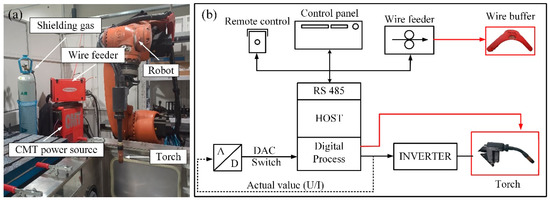
Figure 1.
(a) Experimental setup and (b) schematic diagram of the WAAM-CMT system.
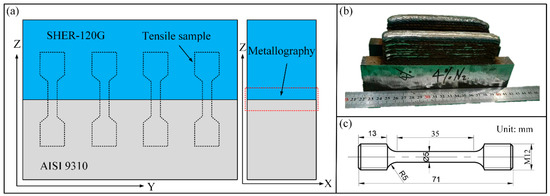
Figure 2.
(a) positions of tested specimens, (b) physical drawing of hybrid manufacturing components and (c) shapes and dimensions of specimens (in mm) for tensile test.
(a) Microstructure and characterization
Metallographic samples were prepared by a standard metallographic procedure for polishing 1μm gypsum. Then, the samples were etched using an etchant consisting of H2O, HCl and HNO3 (16:3:1). The microstructure and phase characterization were assessed via optical microscopy (OM, Olympus-GX71, Shinjuku, Tokyo, Japan), secondary electron microscope (SEM, ZESSIS Inc., Thuringia, Germany) and electron backscatter diffraction (EBSD, OXFORD INSTRUMENTS Ins, Oxford, UK). A JEOL 2100F transmission electron microscope (TEM, PANalytical B.V., Almoro, ND, USA) operating at 200 kV was used to observe nanosized structures and precipitates.
(b) Material property characterization
An electromechanical Instron 5500R (MTS Ins., Eden Prairie, MN, USA) frame based on GB/T228-2010 standard was used for the tensile test. The force measuring element was 100 kN and the crosshead speed was 1 mm/min. Each test had at least four identical samples. The location and dimensions of the tested specimens are illustrated in Figure 2a,c. Fracture morphology of the specimens were observed to reveal the fracture mechanism by using an SEM.
3. Result
3.1. Microstructure of Hybrid-Manufactured SHER120-G Maraging Steel
Figure 3 shows microstructures of the hybrid-manufactured SHER120-G maraging steel sample. Figure 3a,d illustrate the WAAM deposition zone, the grain growth zone and the heat-affected zone (HAZ) in two shielding gas conditions. The grain growth zone with large martensite laths and some lathy δ-ferrite were observed near the interface. Then, a very fine martensitic structure formed in a grain-refinement zone, as shown in Figure 3b,e. It is worth mentioning that the large martensite laths zone containing 4% nitrogen in shielding gas was narrower than that of the sample without nitrogen, while the fine grain zone was the opposite. Figure 3c,f show the microstructure of the specimens in the WAAM deposition zone. It can be clearly observed that the δ-ferrite dendrites gradually decreased. The chemical composition of the substrate was different from the welding wire, which was analysed by EDS from the substrate to the WAAM deposition zone, as shown in Figure 4. The results show that the content of alloying elements, such Cr, Ni, and Mn, increased gradually. In addition, the Fe content decreased.
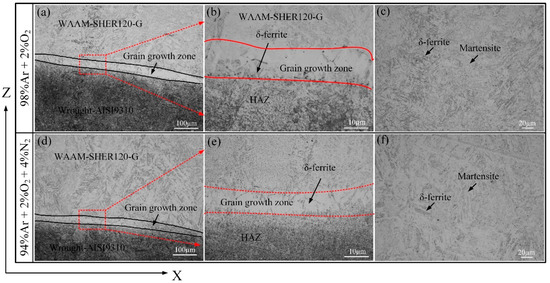
Figure 3.
(a,b,d,e): The wrought-WAAM interface showing two distinct HAZ regions; (c,f): the microstructures of WAAM-fabricated SHER120-G maraging steel taken from the YOZ cross-section.
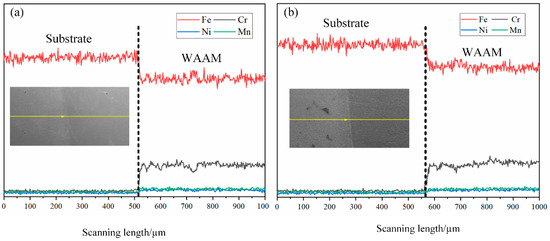
Figure 4.
EDS chemical composition analysis. (a) N2-0% sample; (b) N2-4% sample.
3.2. Microstructures Characterization by EBSD
Figure 5 shows EBSD images of the WAAM deposition zone, the grain growth zone and HAZ in two samples. The columnar grains along the deposition direction had the same structure, as shown in Figure 5a,d. In addition, Figure 5b,d displays (1200 ×) high-magnification images to show the characteristics of the microstructure in the grain growth zone via hybrid-manufacturing. It can be clearly seen that the width of the grain growth was about 40 µm in the N2-0% sample and 30 µm in the N2-4% sample, respectively. In addition, the phase maps were used to identify retained austenite at the interface, as shown in Figure 5c,f. The results showed that the formation of retained austenite was more aggregated in the N2-4% sample. On the contrary, retained austenite uniformly distributed in the gap of the martensite structure in the N2-0% sample.
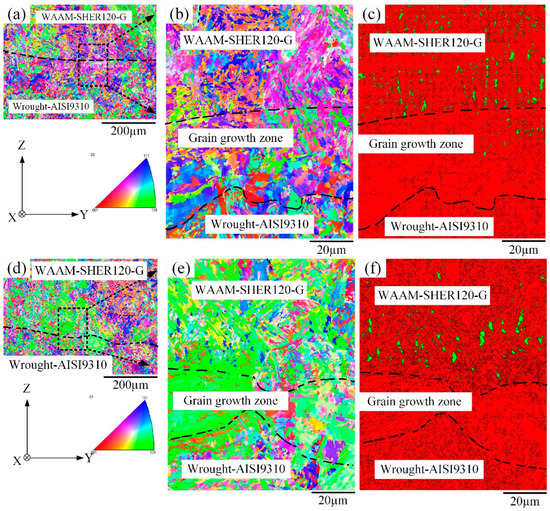
Figure 5.
EBSD unique colour grain maps of (a,b) 98%Ar + 2%O2 and (d,e) 94%Ar + 2%O2 + 4%N2 specimens; phase maps of (c) 98%Ar + 2%O2 and (f) 94%Ar + 2%O2 + 4%N2 specimens. Austenite (FCC) and ferrite/martensite (BCC) are in green and red colors, respectively.
Figure 6 shows the angle boundary and the grain size distribution in two samples using different shielding gases. Figure 6a indicates the proportion of different grain boundaries. High-angle grain boundaries (HAGB) decreased significantly in the N2-4% samples. It is worth mentioning that the grain growth zone was mainly composed of low-angle grain boundaries LAGBs, especially in the N2-0% sample, most of which were angle grain boundaries between 2° to 5°, as shown by the red line in Figure 6b. The grain size distribution showed that the proportion of small grain (in the range of 4 to 6 µm) significantly increased in the N2-4% sample. In addition, the average grain size decreased from 7.9 to 7.5 µm due to the addition of 4% nitrogen, which was also an important factor that affected the mechanical properties.
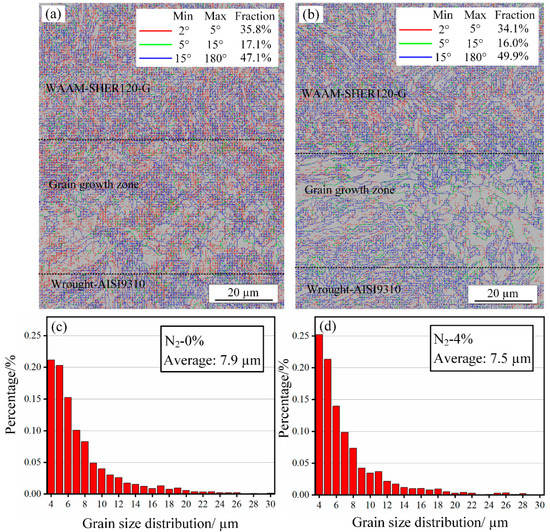
Figure 6.
The fraction of angle boundary distribution in two samples: (a,b) and the corresponding grain size distribution: (c,d).
3.3. XRD
The phases present in the samples were examined by XRD, as shown in Figure 7. The XRD pattern showed that 2.5% retained austenite existed stably in the microstructure of the N2-0% sample. In addition, the retained austenite content increased to 7.6% because of the addition of 4% nitrogen. The martensite (200) and (221) peak heights were increased and the (110) peak heights were decreased in the N2-4% sample. The microstructure of the forging substrate AISI 9310 included martensite as the matrix. However, there was no obvious evidence of nitrides and ε-Cu, which may be due to their low content and dispersed distribution. They will be discussed in the following section.
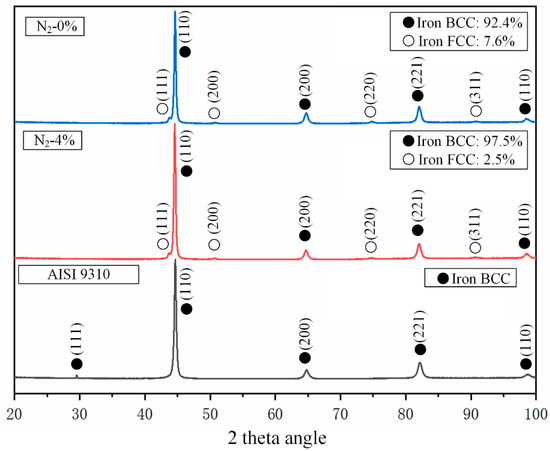
Figure 7.
XRD spectra of samples by hybrid-manufactured.
3.4. TEM
Figure 8 presents the TEM micrographs of the two samples using different shielding gases. The results showed that the microstructure of the sample without nitrogen shielding consisted of typical martensite lath and retained austenite, as shown in Figure 8a. The ε-copper particles dispersed in martensite grain boundaries could also be observed. A zoom-in image of Figure 8c shows the interaction between the ε-copper and dislocations. The results showed that the actual measured lattice spacing in the N2-4% sample (0.2095 nm) was bigger than that in the N2-0% sample (0.2035 nm), which may be due to more N atoms being dissolved in the matrix, as shown in Figure 8c,f. In addition, the N2-4% sample had a smaller martensite width compared to that of the N2-0% sample, as shown in Figure 8d. It is worth mentioning that rod-like Cr2N particles can be observed in Figure 8g. The corresponding SADP and dark filed image in Figure 8h,i revealed that the Cr2N had a close-packed hexagonal structure.
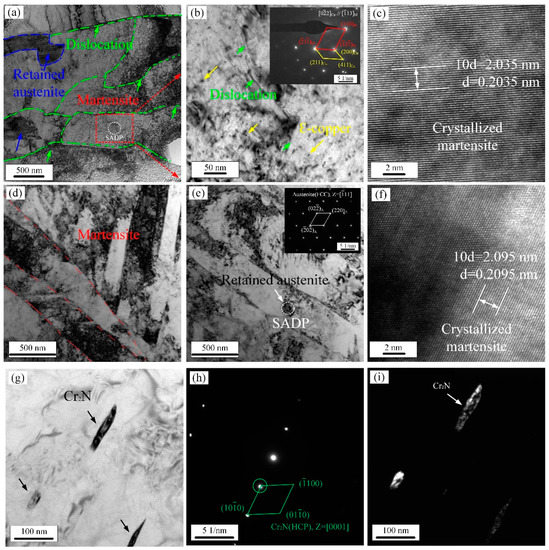
Figure 8.
Microstructure characterization by TEM. WAAM-fabricated N2-0% samples: (a) martensite lath and retained austenite; (b) ε-Cu; (c) the matrix. WAAM-fabricated N2-4% samples; (d) martensite lath; (e) retained austenite with insert SADP; (f) HRTEM of the matrix. (g–i) the bright and dark fields of Cr2N in the matrix.
3.5. Mechanical Properties
The measured microhardness of the two samples is shown in Figure 9. On the whole, the microhardness was relatively stable in the substrate and the as-deposited zone. The microhardness of HAZ was between the substrate and the as-deposited zone and tented to decrease near the interface. The microhardness of the as-deposited zone in the N2-4% sample was greater than that in the N2-0% sample.
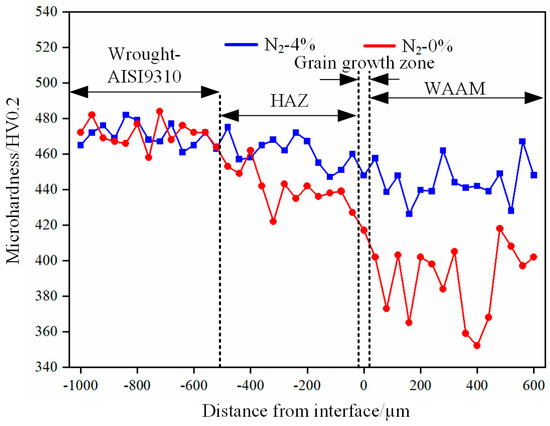
Figure 9.
Microhardness profile of the hybrid-manufactured SHER-120G maraging steel.
The corresponding mechanical properties of the two samples are presented in Table 2. The ultimate tensile strength increased with increasing nitrogen content. The maximum ultimate tensile strength and yield strength for the specimen using 4% nitrogen were found to be 1186.0 MPa and 844.3 MPa, respectively, which are close to the level of the WAAM-fabricated sample. As compared to the sample without nitrogen, this corresponded to an 8.7% increase of UTS and a 9.3% increase of YS. The elongation of the hybrid-manufactured sample decreased significantly compared to that of the WAAM-fabricated samples. However, the hybrid-manufactured sample using 4% nitrogen had a better elongation than that in the sample without nitrogen, which may be attributed to the fine grains. In a word, the mechanical properties of the N2-4% sample were equivalent to those of the sample directly fabricated by WAAM, while those of the hybrid-manufactured samples decreased significantly, to a level far lower than those in the WAAM-fabricated samples. In addition, the fracture position of the N2-4% samples and the N2-0% samples was in the WAAM deposition zone and interface of wrought-WAAM, respectively, as shown in Figure 10.

Table 2.
Tensile properties of hybrid-manufactured and WAMM samples.
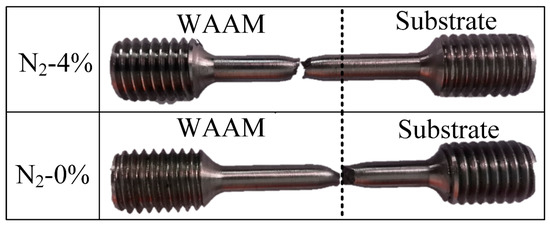
Figure 10.
The fracture position of the hybrid-manufactured components.
Figure 11 shows the fracture surfaces of the two hybrid-manufactured samples. The results showed that the crack (Figure 11b,c) in the N2-0% sample was the main reason for the fracture, which could significantly decrease the tensile strength. In addition, the pores in the N2-0% sample were significantly larger than those in the N2-4% sample. Strength usually depends on porosity, and lower porosity is related to higher strength [18,19]. In addition, the fracture morphology of the N2−0% sample cleavage fracture occurred in some regions, with brittle fracture characteristics. There were no obvious pores in the fracture surface of the N2-4% sample. The fracture was mainly composed of equiaxed dimples, showing the characteristics of good elongation. The increase in dimples indicated that the addition of nitrogen made δ-ferrite almost disappear.
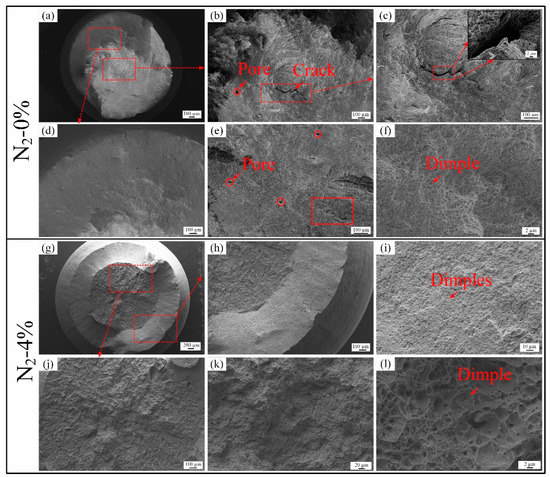
Figure 11.
SEM image of the fracture surfaces of hybrid-manufactured: (a–f) are the N2-0% samples; (g–l) are the N2-4% samples.
4. Discussion
4.1. Behaviour of Nitrogen during WAAM-Process
Under the shielding of nitrogen, there were two methods by which N entered the molten pool during WAAM: first, in the process of wire evaporation, the atmospheric pressure on the droplet edge was much higher than that on the outer side of the droplet. The metal vapor flow in the droplet far exceeded the shielding flow [20]. Secondly, the atmospheric pressure above the surface of the molten pool was about 1 bar. The specific dissolution process was as follows: (1) movement of gas on the interface of the molten pool; (2) dissociation of diatomic nitrogen molecules onto the molten pool surface into monoatomic nitrogen; and (3) the depth of N atoms diffusing to metal after passing through the surface layer of the molten pool. The dissolution of nitrogen in the molten pool can be described by the following expression [21]:
The and Pmetal represent the partial pressure of N2 and metal vapor, respectively.
4.2. The Effect of N on the Microstructure
The WAAM-fabricated SHER120-G maraging steel exhibited a primary ferritic solidification mode [22]. The amount of δ-ferrite that can transform into austenite will be limited due to the inherent cooling rate during the WAAM process. On the other hand, what is considered to be a stable element of δ-ferrite in SHER120-G is Cr (13.55 wt%). There will be δ-ferrite in the microstructure when Cr content in steel exceeds 13% [23]. It should be noted that, after adding 4% nitrogen to shielding gas, the δ-ferrite content in the microstructure decreased significantly and the austenite content increased from 2.5% to 7.6%. As many studies have reported, N is a strong austenite stabilizer, and nitrogen accelerates the formation of δ-ferrite to austenite. Therefore, slight δ ferrite will remain as-deposited during WAAM [24,25,26]. N atoms that segregate at austenite grain boundaries can easily reduce the binding force of Fe atoms, which promotes the growth of austenite grains, thus, reducing the content of δ-ferrite due to the addition of nitrogen in shielding gas.
4.3. Formation Mechanism of Grain Growth Zone
The final structures in the grain growth zone are strongly dependent on the ratio of the temperature gradient to the solidification rate (G/R) [27,28]. The temperature of the substrate was low because of the small heat input when the first layer was deposited. As a result, G was highest at the bottom of the bath; R was close to 0, so the ratio of G/R was large, and the solidification structure expanded and grew in plane. Therefore, the grain growth zone was formed at the beginning of the WAAM process. From the bottom of the pool, R increased and G/R decreased. Along the stacking direction, that is, the direction of heat flow, a cell dendritic structure was formed. With the further decrease of G/R, the microstructure transformed into a cellular structure.
4.4. Nano-Precipitation Characteristics
Nanoprecipitation, such as in ε-copper and Cr2N, is another matter worthy of attention [29,30,31]. As shown by the above analysis, ε-copper particles cannot easily precipitate in the deposition process; most of them exist in the matrix in the form of solid solution [32,33]. According to Xiong [34], each deposition layer raises the temperature of the upper layer to above 450 °C during WAAM. This will lead to the transient aging effect, which results in many ε-copper particles in the as-deposited components. However, due to the limited residence time and the lack of constant temperature, the effect of transient aging cannot be comparable with the actual aging treatment [35]. The reaction between N atoms and Cr generates Cr2N in the molten pool, which may promote heterogeneous nucleation and reduce martensitic transformation temperature (Ms) [36].
4.5. Fracture Mechanism
The UTS of the N2-0% sample was lower than the substrate metal and the WAAM-fabricated components, according to the above description, from which it can be seen that all tensile fractures occurred in the grain growth zone; in Figure 11, crack can clearly be observed in the fracture surfaces. This is because the grain growth zone was mainly composed of large martensitic lath, while the deformation interface of WAAM was mainly distributed with a columnar crystal structure, so the tensile strength was poor [37]. As the stress was concentrated on the notch at the grain growth zone, tensile specimens cracked and, finally, caused the fracture around the fusion line [38,39].
Both UTS and YS of the N2-4% sample reached the level of WAAM-fabricated samples, indicating that the addition of nitrogen would enhance the strength of the grain growth zone. The N atoms solid solution content of the matrix, and precipitation, such as Cr2N and ε-copper, are the main strengthening mechanisms [40,41,42]. Description of the strengthening mechanisms about ε-copper particles is not the point of this paper, since there are several reports that describe metallurgy and the mechanics of the steel [17,42,43]. Sub-grain boundary strengthening induced by Cr2N inhibits grain growth as follows [44]:
where λsg is the lath width, and Gs and b are the shear modulus and the Burger vector length, respectively, according to the EBSD and TEM images in Figure 5 and Figure 8, respectively. The martensite lath width of the N2-4% sample was finer than that of the N2-0% sample; the grain growth zone of the N2-4% sample was smaller. In addition, the average grain size of the N2-4% sample was 7.5 µm, which was finer than that of the N2-0% sample (7.9 µm). The addition of nitrogen enhanced the strength of the grain growth zone in hybrid-manufactured components, which can be attributed to three factors: (a) a finer martensite lath, (b) a δ-ferrite-free microstructure, and (c) the interstitial solid solution is strengthened by diffusion of nitrogen.
5. Conclusions
In this study, microstructures and mechanical properties of wrought-WAAM hybrid-manufactured SHER120-G maraging steel were studied, with an emphasis on the heat-affected zone.
(1). The microstructure of hybrid-manufactured component can be divided into the WAAM deposition zone, the grain growth zone, HAZ and the substrate AISI 9310.
(2). The grain growth zone with large martensite laths and some lathy δ-ferrite determined the final mechanical properties. In the WAAM deposition zone, the austenite content increased from 2.5% to 7.6% and the δ-ferrite decreased because of the addition of 4% nitrogen.
(3). The fracture position shifted from the grain growth zone of the N2-0% sample to the WAAM deposition zone of the N2-4% sample, which was caused by a series of strengthening machines, including solid solution and grain size.
(4). Nano-precipitate Cr2N offers an important contribution to grain refinement, which is considered to be the main mechanism to improve the mechanical properties of the grain growth zone.
(5). The tensile strength of the hybrid-manufactured SHER-120G maraging steel sample using 4% nitrogen was 1186 MPa, which is approaching the level of the WAAM-fabricated sample.
Author Contributions
Writing—review and editing, F.D. and G.Y.; Investigation, S.Z.; Resources, L.Q. and B.W.; Formal analysis, J.Z. All authors have read and agreed to the published version of the manuscript.
Funding
This work was supported by the National Natural Science Foundation of China under grant nos. (51975387, 52005351); and the Natural Science Foundation of Liaoning Province of China under grant no. [2021-BS-193].
Institutional Review Board Statement
Not applicable.
Informed Consent Statement
Not applicable.
Data Availability Statement
Data sharing is not applicable to this article.
Conflicts of Interest
The authors declare no conflict of interest.
References
- Fang, X.; Zhang, L.; Chen, G.; Huang, K.; Xue, F.; Wang, L.; Zhao, J.; Lu, B. Microstructure evolution of wire-arc additively manufactured 2319 aluminum alloy with interlayer hammering. Mater. Sci. Eng. A 2021, 800, 140168. [Google Scholar] [CrossRef]
- Martina, F.; Ding, J.; Williams, S.; Caballero, A.; Pardal, G.; Quintino, L. Tandem metal inert gas process for high productivity wire arc additive manufacturing in stainless steel. Addit. Manuf. 2019, 25, 545–550. [Google Scholar] [CrossRef] [Green Version]
- Xu, X.; Ding, J.; Ganguly, S.; Diao, C.; Williams, S. Preliminary Investigation of Building Strategies of Maraging Steel Bulk Material Using Wire + Arc Additive Manufacture. J. Mater. Eng. Perform. 2018, 28, 594–600. [Google Scholar] [CrossRef]
- Facchini, L.; Vicente, N.; Lonardelli, I.; Magalini, E.; Robotti, P.; Molinari, A. Metastable Austenite in 17-4 Precipitation-Hardening Stainless Steel Produced by Selective Laser Melting. Adv. Eng. Mater. 2010, 12, 184–188. [Google Scholar] [CrossRef]
- Liu, H.; Gao, Y.; Qi, L.; Wang, Y.; Nie, J.-F. Phase-Field Simulation of Orowan Strengthening by Coherent Precipitate Plates in an Aluminum Alloy. Met. Mater. Trans. A 2015, 46, 3287–3301. [Google Scholar] [CrossRef]
- Kennedy, J.; Davis, A.; Caballero, A.; Williams, S.; Pickering, E.; Prangnell, P. The potential for grain refinement of Wire-Arc Additive Manufactured (WAAM) Ti-6Al-4V by ZrN and TiN inoculation. Addit. Manuf. 2021, 40, 101928. [Google Scholar] [CrossRef]
- Yoo, W.D.; Lee, J.H.; Youn, K.T.; Rhyim, Y.M. Study on the Microstructure and Mechanical Properties of 17-4 PH Stainless Steel Depending on Heat Treatment and Aging Time. Solid State Phenom. 2006, 118, 15–20. [Google Scholar] [CrossRef]
- Nemani, A.V.; Ghaffari, M.; Salahi, S.; Lunde, J.; Nasiri, A. Effect of interpass temperature on the formation of retained austenite in a wire arc additive manufactured ER420 martensitic stainless steel. Mater. Chem. Phys. 2021, 266, 124555. [Google Scholar] [CrossRef]
- Ding, D.; Pan, Z.; Cuiuri, D.; Li, H. Wire-feed additive manufacturing of metal components: Technologies, developments and future interests. Int. J. Adv. Manuf. Technol. 2015, 81, 465–481. [Google Scholar] [CrossRef]
- Szost, B.A.; Terzi, S.; Martina, F.; Boisselier, D.; Prytuliak, A.; Pirling, T.; Hofmann, M.; Jarvis, D.J. A comparative study of additive manufacturing techniques: Residual stress and microstructural analysis of CLAD and WAAM printed Ti–6Al–4V components. Mater. Des. 2016, 89, 559–567. [Google Scholar] [CrossRef] [Green Version]
- Samei, J.; Asgari, H.; Pelligra, C.; Sanjari, M.; Salavati, S.; Shahriari, A.; Amirmaleki, M.; Jahanbakht, M.; Hadadzadeh, A.; Amirkhiz, B.S.; et al. A hybrid additively manufactured martensitic-maraging stainless steel with superior strength and corrosion resistance for plastic injection molding dies. Addit. Manuf. 2021, 45, 102068. [Google Scholar] [CrossRef]
- Kim, H.; Abell, N.; Cheatham, L.; Paek, I. Development and Validation of the Attitudes toward Education for Older Adults (AEOA) Scale. Educ. Gerontol. 2017, 43, 341–355. [Google Scholar] [CrossRef]
- Zhu, Y.; Li, J.; Tian, X.; Wang, H.; Liu, D. Microstructure and mechanical properties of hybrid fabricated Ti–6.5Al–3.5Mo–1.5Zr–0.3Si titanium alloy by laser additive manufacturing. Mater. Sci. Eng. A 2014, 607, 427–434. [Google Scholar] [CrossRef]
- Caballero, A.; Ding, J.; Ganguly, S.; Williams, S. Wire + Arc Additive Manufacture of 17-4 PH stainless steel: Effect of different processing conditions on microstructure, hardness, and tensile strength. J. Mater. Process. Technol. 2019, 268, 54–62. [Google Scholar] [CrossRef]
- Chen, Z.; Zhou, G.; Chen, Z. Microstructure and hardness investigation of 17-4PH stainless steel by laser quenching. Mater. Sci. Eng. A 2012, 534, 536–541. [Google Scholar] [CrossRef]
- Lin, X.; Cao, Y.; Wu, X.; Yang, H.; Chen, J.; Huang, W. Microstructure and mechanical properties of laser forming repaired 17-4PH stainless steel. Mater. Sci. Eng. A 2012, 553, 80–88. [Google Scholar] [CrossRef]
- Yang, G.; Deng, F.; Zhou, S.; Wu, B.; Qin, L.; Zheng, J. Influence of shielding gas nitrogen content on the microstructure and mechanical properties of Cu-reinforced maraging steel fabricated by wire arc additive manufacturing. Mater. Sci. Eng. A 2021, 832, 142463. [Google Scholar] [CrossRef]
- Lei, X.; Feng, Y.; Zhang, J.; Fu, A.; Yin, C.; Macdonald, D.D. Impact of Reversed Austenite on the Pitting Corrosion Behavior of Super 13Cr Martensitic Stainless Steel. Electrochim. Acta 2016, 191, 640–650. [Google Scholar] [CrossRef]
- Tan, C.; Zhou, K.; Ma, W.; Zhang, P.; Liu, M.; Kuang, T. Microstructural evolution, nanoprecipitation behavior and mechanical properties of selective laser melted high-performance grade 300 maraging steel. Mater. Des. 2017, 134, 23–34. [Google Scholar] [CrossRef]
- Vashishtha, H.; Taiwade, R.V.; Sharma, S.; Patil, A.P. Effect of welding processes on microstructural and mechanical properties of dissimilar weldments between conventional austenitic and high nitrogen austenitic stainless steels. J. Manuf. Process. 2017, 25, 49–59. [Google Scholar] [CrossRef]
- Zhang, X.; Zhou, Q.; Wang, K.; Peng, Y.; Ding, J.; Kong, J.; Williams, S. Study on microstructure and tensile properties of high nitrogen Cr-Mn steel processed by CMT wire and arc additive manufacturing. Mater. Des. 2019, 166, 107611. [Google Scholar] [CrossRef]
- Zhao, H.; Zhang, G.; Yin, Z.; Wu, L. A 3D dynamic analysis of thermal behavior during single-pass multi-layer weld-based rapid prototyping. J. Mater. Process. Technol. 2011, 211, 488–495. [Google Scholar] [CrossRef]
- Gao, C.; Chen, X.; Su, C.; Chen, X. Location dependence of microstructure and mechanical properties on wire arc additively manufactured nuclear grade steel. Vacuum 2019, 168, 108818. [Google Scholar] [CrossRef]
- Liu, Y.; Zhang, J.; You, Q.; Zhang, L. A novel martensitic steel powder for plasma arc direct energy deposition to remanufacture broken gear teeth. Mater. Lett. 2021, 301, 130111. [Google Scholar] [CrossRef]
- Song, M.; Zhou, R.; Gu, J.; Wang, Z.; Ni, S.; Liu, Y. Nitrogen induced heterogeneous structures overcome strength-ductility trade-off in an additively manufactured high-entropy alloy. Appl. Mater. Today 2020, 18, 100498. [Google Scholar] [CrossRef]
- Yang, D.; Huang, Y.; Fan, J.; Jin, M.; Peng, Y.; Wang, K. Effect of N2 content in shielding gas on formation quality and microstructure of high nitrogen austenitic stainless steel fabricated by wire and arc additive manufacturing. J. Manuf. Process. 2021, 61, 261–269. [Google Scholar] [CrossRef]
- Xu, X.; Ganguly, S.; Ding, J.; Guo, S.; Williams, S.; Martina, F. Microstructural evolution and mechanical properties of maraging steel produced by wire + arc additive manufacture process. Mater. Charact. 2018, 143, 152–162. [Google Scholar] [CrossRef]
- Busby, J.T.; Hash, M.C.; Was, G.S. The relationship between hardness and yield stress in irradiated austenitic and ferritic steels. J. Nucl. Mater. 2005, 336, 267–278. [Google Scholar] [CrossRef]
- Wu, S.; Zheng, K.; Zou, J.; Jiang, F.; Han, X. A study of the behavior and effects of nitrogen take-up from protective gas shielding in laser welding of stainless steel. J. Manuf. Process. 2018, 34, 477–485. [Google Scholar] [CrossRef]
- Zhong, Y.; Rännar, L.-E.; Liu, L.; Koptyug, A.; Wikman, S.; Olsen, J.; Cui, D.; Shen, Z. Additive manufacturing of 316L stainless steel by electron beam melting for nuclear fusion applications. J. Nucl. Mater. 2017, 486, 234–245. [Google Scholar] [CrossRef]
- Cheng, S.; Cheng, F.; Zhang, Y.; Shao, Z.; Kong, K.; Wu, S. Effects of N2-mixed shielding gas on the ferrite number and microstructure of 304L multi-pass GTAW joint. Sadhana 2020, 45, 182. [Google Scholar] [CrossRef]
- Sun, Y.; Zhong, Y.; Wang, L. The interaction between ε-copper and dislocation in a high copper 17-4PH steel. Mater. Sci. Eng. A 2019, 756, 319–327. [Google Scholar] [CrossRef]
- Donoghue, J.; Antonysamy, A.; Martina, F.; Colegrove, P.; Williams, S.; Prangnell, P. The effectiveness of combining rolling deformation with Wire–Arc Additive Manufacture on β-grain refinement and texture modification in Ti–6Al–4V. Mater. Charact. 2016, 114, 103–114. [Google Scholar] [CrossRef]
- Xiong, J.; Lei, Y.; Li, R. Finite element analysis and experimental validation of thermal behavior for thin-walled parts in GMAW-based additive manufacturing with various substrate preheating temperatures. Appl. Therm. Eng. 2017, 126, 43–52. [Google Scholar] [CrossRef]
- Brookes, K.J. Maraging steel for additive manufacturing—Philipp Stoll’s paper at DDMC 2016. Met. Powder Rep. 2016, 71, 149–152. [Google Scholar] [CrossRef]
- Zhang, Z.; Jing, H.; Xu, L.; Han, Y.; Zhao, L.; Zhou, C. Effects of nitrogen in shielding gas on microstructure evolution and localized corrosion behavior of duplex stainless steel welding joint. Appl. Surf. Sci. 2017, 404, 110–128. [Google Scholar] [CrossRef]
- Xu, X.; Ganguly, S.; Ding, J.; Dirisu, P.; Martina, F.; Liu, X.; Williams, S.W. Improving mechanical properties of wire plus arc additively manufactured maraging steel through plastic deformation enhanced aging response. Mater. Sci. Eng. A 2019, 747, 111–118. [Google Scholar] [CrossRef] [Green Version]
- Li, S.; Zhang, L.-J.; Ning, J.; Wang, X.; Zhang, G.-F.; Zhang, J.-X.; Na, S.-J.; Fatemeh, B. Comparative study on the microstructures and properties of wire+arc additively manufactured 5356 aluminium alloy with argon and nitrogen as the shielding gas. Addit. Manuf. 2020, 34, 101206. [Google Scholar] [CrossRef]
- Freeman, F.; Sharp, J.; Xi, J.; Todd, I. Influence of solidification cell structure on the martensitic transformation in additively manufactured steels. Addit. Manuf. 2019, 30, 100917. [Google Scholar] [CrossRef]
- Zhang, Z.; Jing, H.; Xu, L.; Han, Y.; Zhao, L.; Zhang, J. Influence of microstructure and elemental partitioning on pitting corrosion resistance of duplex stainless steel welding joints. Appl. Surf. Sci. 2017, 394, 297–314. [Google Scholar] [CrossRef]
- Kok, Y.; Tan, X.; Wang, P.; Nai, M.; Loh, N.; Liu, E.; Tor, S.B. Anisotropy and heterogeneity of microstructure and mechanical properties in metal additive manufacturing: A critical review. Mater. Des. 2018, 139, 565–586. [Google Scholar] [CrossRef]
- Yang, G.; Deng, F.; Zhou, S.; Wu, B.; Qin, L. Microstructure and mechanical properties of a novel Cu-reinforced maraging steel for wire arc additive manufacturing. Mater. Sci. Eng. A 2021, 825, 141894. [Google Scholar] [CrossRef]
- Trzepieciński, T.; Pieja, T.; Malinowski, T.; Smusz, R.; Motyka, M. Investigation of 17-4PH steel microstructure and conditions of elevated temperature forming of turbine engine strut. J. Mater. Process. Technol. 2018, 252, 191–200. [Google Scholar] [CrossRef]
- Yan, P.; Liu, Z.; Bao, H.; Weng, Y.; Liu, W. Effect of normalizing temperature on the strength of 9Cr–3W–3Co martensitic heat resistant steel. Mater. Sci. Eng. A 2014, 597, 148–156. [Google Scholar] [CrossRef]
Publisher’s Note: MDPI stays neutral with regard to jurisdictional claims in published maps and institutional affiliations. |
© 2022 by the authors. Licensee MDPI, Basel, Switzerland. This article is an open access article distributed under the terms and conditions of the Creative Commons Attribution (CC BY) license (https://creativecommons.org/licenses/by/4.0/).